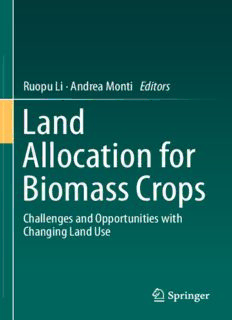
Land Allocation for Biomass Crops PDF
Preview Land Allocation for Biomass Crops
Ruopu Li · Andrea Monti Editors Land Allocation for Biomass Crops Challenges and Opportunities with Changing Land Use Land Allocation for Biomass Crops Ruopu Li • Andrea Monti Editors Land Allocation for Biomass Crops Challenges and Opportunities with Changing Land Use 123 Editors RuopuLi AndreaMonti DepartmentofGeographyand AlmaMaterStudiorum–University EnvironmentalResources ofBologna SouthernIllinoisUniversity-Carbondale Bologna,Italy Carbondale,IL,USA ISBN978-3-319-74535-0 ISBN978-3-319-74536-7 (eBook) https://doi.org/10.1007/978-3-319-74536-7 LibraryofCongressControlNumber:2018942054 ©SpringerInternationalPublishingAG,partofSpringerNature2018 Thisworkissubjecttocopyright.AllrightsarereservedbythePublisher,whetherthewholeorpartof thematerialisconcerned,specificallytherightsoftranslation,reprinting,reuseofillustrations,recitation, broadcasting,reproductiononmicrofilmsorinanyotherphysicalway,andtransmissionorinformation storageandretrieval,electronicadaptation,computersoftware,orbysimilarordissimilarmethodology nowknownorhereafterdeveloped. Theuseofgeneraldescriptivenames,registerednames,trademarks,servicemarks,etc.inthispublication doesnotimply,evenintheabsenceofaspecificstatement,thatsuchnamesareexemptfromtherelevant protectivelawsandregulationsandthereforefreeforgeneraluse. Thepublisher,theauthorsandtheeditorsaresafetoassumethattheadviceandinformationinthisbook arebelievedtobetrueandaccurateatthedateofpublication.Neitherthepublishernortheauthorsor theeditorsgiveawarranty,expressorimplied,withrespecttothematerialcontainedhereinorforany errorsoromissionsthatmayhavebeenmade.Thepublisherremainsneutralwithregardtojurisdictional claimsinpublishedmapsandinstitutionalaffiliations. Printedonacid-freepaper ThisSpringerimprintispublishedbytheregisteredcompanySpringerInternationalPublishingAGpart ofSpringerNature. Theregisteredcompanyaddressis:Gewerbestrasse11,6330Cham,Switzerland Foreword During the last 20 years, my research has evolved from field work with energy and industrial crops to modelling and assessment of the economic, environmental and social sustainability of biomass value chains. Resource efficiency and use of marginal lands for such crops form part of both my recent research area in respective collaborative projects and my teaching topics for graduate students of various disciplines. This book brings together knowledge from recent work with variouslignocellulosicandherbaceousnon-foodcrops,andaddressesthechallenges and opportunities of their cultivation in low quality and marginal lands. I strongly believeitbringshigh-addedvaluestoeveryoneinterestedinthisfield. The editors, Ruopu Li and Andrea Monti, brought together a group of dis- tinguished authors who have not only provided comprehensive documentation of research conducted for land use and biomass production, but also unique and valuableanalysesofinformationthathavenotbeenpublishedelsewhere. Thebook content reflects recentdevelopments, trends and advances inthearea and includes a set of well-integrated, original research contributions that focus on state-of-the-art research. It addresses opportunities and challenges associated with the allocation of land resources to biomass cropping and offers valuable contribu- tions to informed land management decision-making. The individual chapters are organized in response to cutting-edge questions associated with biofuels-related land-useissuesinmanycountriessuchasSpain,Brazil,USAandChina,andfurther provideinformedandtailoredinsights. Chapters 2, 3 and 4 address the availability of land, especially marginal cate- gories, to accommodate future cultivation of lignocellulosic and other specialized herbaceous biofuel crops. More specifically, in Chap. 2, Sánchez et al. address two key challenges for bioenergy implementation: (i) ‘Do we have land available to accommodate future biomass production?’ (ii) ‘What would be the choice of energy crops from the knowledge gained in field experiments?’, with a specific focusinSpain.InChap.3,Parentietal.evaluatepossibilitiesandlimitationsforthe cultivation of two promising perennial biofuel crops (giant reed and switchgrass) in Europe, in areas with natural constraints (ANC land). In Chap. 4, Chen et al. analysetheavailabilityandeconomicfeasibilityofusingmarginallandstocultivate v vi Foreword five energy plant species, namely Manihot esculenta, Jatropha curcas, Helianthus tuberous L, Pistacia chinensis and Xanthoceras sorbifolia Bunge. Barbosa et al. analyse the opportunities of using contaminated land, for biomass production, in Chap.5. Chapters 6, 7 and 8 analyse the combination of employing diverse approaches (e.g. economic models and surveying) in three case studies with a focus on dynamicsonfarmers’plantingdecisions.Morespecifically,inChap.6,Grancoetal. presentthefindingsofastudyonhowBrazilianfarmersdecidewhichagricultural productiontopursueandwhichlandusetoreplaceinthenewfrontierofsugarcane production. Varble and Secchi, in Chap. 7, examine the factors that are significant indicatorsintheinterestoffarmerstoproduceswitchgrassthroughtheanalysisof theresultsofasurveycompletedbyfarmersintheClearCreekwatershedinrural Iowa.InChap.8,Kurkalovaetal.evaluateland-useimpactsofcornstovermarkets forthestateofIowa,aswell. Zhang et al., in Chap. 9, tackle the carbon sequestration capacity of farmland stoverusingacarboncapturemodelandlanduseandcropyielddatasetsinaregion ofNorthChina.Finally,Dumortier,inChap.10,usesaneconomicmodeltoidentify the effects of plausible scenarios of cellulosic biofuel mandate on land allocation, nitrogenuseandfarmers’participationinUSConservationReserveProgram(CRP). Thebookaddressesawideaudience: (cid:129) Professors,graduatestudentsandresearchersthatworkwithland-usemodelling andfieldcropresearch:therelevantchaptersoffercomprehensiveandtransparent informationonmethodologicalapproaches,fieldworkandmodelling,aswellas a scientific sound discussion on the research results (robustness of the results, strengthsandweaknessesoftheapproach,futureresearch,etc.);and (cid:129) Policyanddecisionmakers:thebookincludesthoroughlyanalysedevidencefor the environmental, economic and social implications from using marginal land forbiofuelcropsaswellasthedynamicsoffarmers’plantingdecisions. In summary, this book is a milestone on the path to understand land use for biomass and biofuels production. It is a recommended reference for anyone who hasaninterestinsuchissues,regardlessofwhether,ornottheyhaveanyexperience or knowledge of land use modelling or field crop research for biofuels. Without question,Iwilluseitinmyresearchandhighlyrecommendittomystudents. ImperialCollegeLondon CalliopePanoutsou London,UK Contents Introduction ...................................................................... 1 RuopuLiandAndreaMonti TrendsinLandUseinSpainandtheirMeaningtoBioenergy Production ........................................................................ 7 Javier Sánchez, Pedro Luis Aguado, María Dolores Curt, andJesúsFernández Areas with Natural Constraints to Agriculture: Possibilities and Limitations for The Cultivation of Switchgrass (Panicum VirgatumL.)andGiantReed(ArundoDonaxL.)inEurope................ 39 ParentiAndrea,LambertiniCarla,andAndreaMonti TheAvailabilityandEconomicAnalysesofUsingMarginalLand forBioenergyProductioninChina............................................. 65 YuqiChen,XiubinLi,XudongGuo,andChunyanLv ProductionofEnergyCropsinHeavyMetalsContaminatedLand: OpportunitiesandRisks......................................................... 83 BrunoBarbosa,JorgeCosta,andAnaLuisaFernando Farmers’AcreageResponsestotheExpansionoftheSugarcane EthanolIndustry:TheCaseofGoiásandMatoGrossoDoSul,Brazil.... 103 Gabriel Granco, Marcellus Caldas, Allen Featherstone, AnaCláudiaSant’Anna,andJasonBergtold Growing Switchgrass in the Corn Belt: Barriers and Drivers fromanIowaSurvey............................................................. 125 SarahVarbleandSilviaSecchi ImpactofStoverCollectiononIowaLandUse............................... 145 LyubovA.KurkalovaandDatQ.Tran vii viii Contents Spatial-TemporalChangeofAgriculturalBiomassandCarbon CaptureCapabilityintheMid-SouthofHebeiProvince.................... 159 YucuiZhang,QiaoliHu,DengpanXiao,XingranLiu,andYanjunShen Changes in Nitrogen Application and Conservation Reserve ProgramAreafromCellulosicBiofuelProductionintheUnitedStates... 189 JeromeDumortier Index............................................................................... 211 Contributors Pedro LuisAguado Agro-Energy Group, College of Agricultural Engineering, TechnicalUniversityofMadrid,Madrid,Spain ParentiAndrea Department of Agricultural and Food Sciences, University of Bologna,Bologna,Italy BrunoBarbosa UniversidadeNovadeLisboa,FaculdadedeCiênciaseTecnolo- gia, Departamento de Ciências e Tecnologia da Biomassa, MEtRiCS, Caparica, Portugal UniversidadedeSãoPaulo,SãoPaulo,Brazil JasonBergtold Kansas State University, Department of Agricultural Economics, Manhattan,KS,USA MarcellusCaldas KansasStateUniversity,DepartmentofGeography,Manhattan, KS,USA LambertiniCarla Department of Agricultural and Food Sciences, University of Bologna,Bologna,Italy YuqiChen ChinaLandSurveyingandPlanningInstitute,KeyLaboratoryofLand Use,MinistryofLandandResource,Beijing,China JorgeCosta Universidade Nova de Lisboa, Faculdade de Ciências e Tecnologia, DepartamentodeCiênciaseTecnologiadaBiomassa,MEtRiCS,Caparica,Portugal María DoloresCurt Agro-Energy Group, College of Agricultural Engineering, TechnicalUniversityofMadrid,Madrid,Spain JeromeDumortier School of Public and Environmental Affairs, Indiana Univer- sity–PurdueUniversityIndianapolis,Indianapolis,IN,USA AllenFeatherstone Kansas State University, Department of Agricultural Eco- nomics,Manhattan,KS,USA ix x Contributors JesúsFernández Agro-EnergyGroup,CollegeofAgriculturalEngineering,Tech- nicalUniversityofMadrid,Madrid,Spain Ana LuisaFernando Universidade Nova de Lisboa, Faculdade de Ciências e Tecnologia, Departamento de Ciências e Tecnologia da Biomassa, MEtRiCS, Caparica,Portugal GabrielGranco StroudWaterResearchCenter,Avondale,PA,USA XudongGuo China Land Surveying and Planning Institute, Key Laboratory of LandUse,MinistryofLandandResource,Beijing,China QiaoliHu ZhongkeHaihuiTechnologyCo.,Ltd,Beijing,China Lyubov A.Kurkalova Departments ofEconomics andEnergyandEnvironmen- talSystems,NorthCarolinaA&TStateUniversity,Greensboro,NC,USA RuopuLi Department of Geography and Environmental Resources, Southern IllinoisUniversity-Carbondale,Carbondale,IL,USA XiubinLi ChinaLandSurveyingandPlanningInstitute,KeyLaboratoryofLand Use,MinistryofLandandResource,Beijing,China XingranLiu KeyLaboratoryofAgriculturalWaterResources&HebeiKeyLab- oratoryofAgriculturalWater-Saving,CenterforAgriculturalResourcesResearch, Institute of Genetics and Developmental Biology, Chinese Academy of Sciences, Shijiazhuang,China ChunyanLv China Land Surveying and Planning Institute, Key Laboratory of LandUse,MinistryofLandandResource,Beijing,China AndreaMonti AlmaMaterStudiorum–UniversityofBologna,Bologna,Italy JavierSánchez Agro-Energy Group, College of Agricultural Engineering, Tech- nicalUniversityofMadrid,Madrid,Spain Ana CláudiaSant’Anna TheOhioStateUniversity,DepartmentofAgricultural, Environmental,andDevelopmentEconomics,Columbus,OH,USA SilviaSecchi UniversityofIowa,Iowa,IA,USA YanjunShen KeyLaboratoryofAgriculturalWaterResources&HebeiKeyLab- oratoryofAgriculturalWater-Saving,CenterforAgriculturalResourcesResearch, Institute of Genetics and Developmental Biology, Chinese Academy of Sciences, Shijiazhuang,China Dat Q.Tran DepartmentofAgriculturalEconomicsandAgribusiness,University ofArkansas,Fayetteville,AR,USA SarahVarble SouthernIllinoisUniversity-Carbondale,Carbondale,IL,USA
Description: